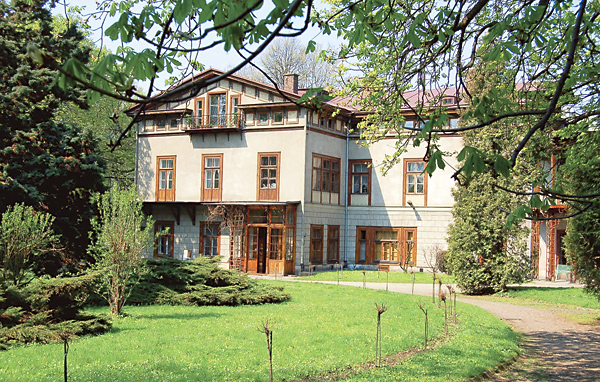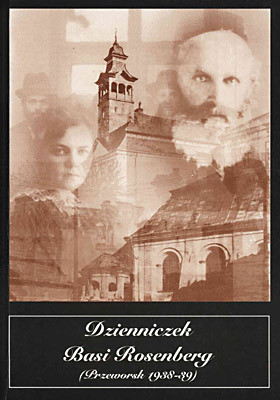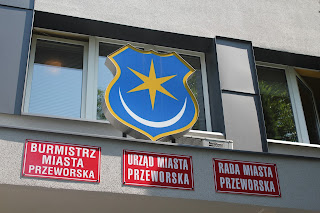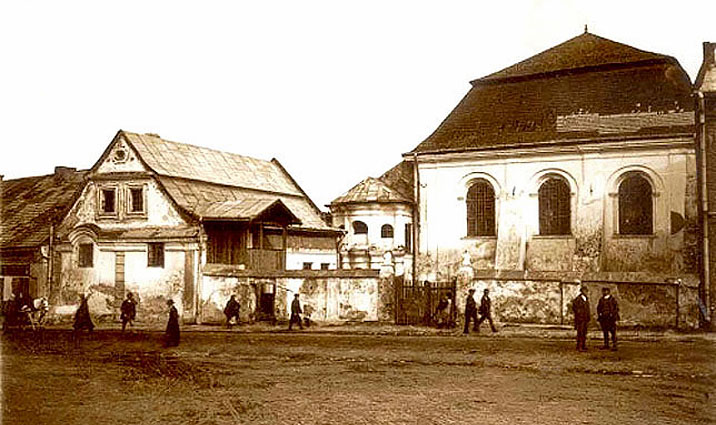The three of us, led by Jakub, went into Przeworsk's
Ratusz/town hall to look for records, as municipalities are supposed to hold those
that are less than one hundred years old.
Older than that, and they go into regional Polish archives in bigger cities; in
Przeworsk's case, Przemysl.
The entrance to the Ratusz was now in the back, in
a new addition whose construction was photographed the day Google came by in
2013.
Now it was finished and little kids played by the fountain.
We came to an office occupied by two women in their sixties;
John Paul II's picture was on the wall.
Jakub explained the reason for our visit and they explained back,
through him, that they couldn't help us; only marriage records were kept
there. We wanted another municipal
office, they said; the one by the elephants.
Elephants? Were they
pulling our leg? We walked to Jakub's
car, looking for elephants on signs or in store windows, then went a few blocks
west on E40 until we came upon a pair of elephants on the road's grassy median.
They were topiaries. Cute green elephants,
made of hedges, with red carpet saddles. And across the street from them was
another office building, at the end of a flowery walkway, showing Przework's by now familiar coat of arms, with
the star and crescent.
Actually, I think there's something between Poles and
elephants. They're a motif I saw painted on baroque buildings in Tarnow and elsewhere.
Anyway, we entered this municipal building, whose halls
looked just like town halls anywhere, with signs boosting Przeworsk and everything that happens there,
culturally, athletically, educationally, commercially. We were directed up the stairs to another,
smaller office, where two younger women, sitting at keyboards, also listened to
our quest via Jakub.
They were very sorry, but Przeworsk was no longer holding
any town records; everything, recent to ancient, was now stored in Przemysl.
Disappointing, but Przemysl was on our itinerary that day, anyway. I saw a map of Przeworsk on the wall, the
kind framed with squares of local advertising, and asked them if they had any
more copies. They apologized again. We thanked them and went back down the
stairs.
Before we reached the first floor, the women called down
after us and gave us the map from the wall, rolled up; a consolation prize. I now have a nice map of Przeworsk and
immediate vicinity, with the ads of many local businesses, mostly in home
improvement, all around it.
Suzanne
Wertheim's web page on Przeworsk had mentioned a local teacher, a Mr.
Thomas, who had helped her identify old sites from pictures. Jakub thought of inquiring in Przeworsk's
public library -- also conveniently
located near the elephants. I sat down at
a PC and launched the familiar refrain of a Windows boot-up while he went
to ask the local librarians if they knew
of this teacher. Again, no luck. And not much English, not even from the young
civil servants. Sympathetic smiles, at
least. And Windows, in Polish.
We were about to set out for Przemysl, the town after
Jaroslaw, when I remembered that I'd seen a Przeworsk museum on the web. That too, was nearby, in a park that had been
another Lubomirski estate. The museum itself looked like an old elegant
country house.
 I wasn't sure why I thought of the museum; I wasn't much interested in the case of surviving Judaica mentioned on their site; I know what menorahs and tefillin look like. Nor did we want to see any more aristocratic interiors, or the historical firefighting exhibit. Again, another entrance, another explanation in the native language.
I wasn't sure why I thought of the museum; I wasn't much interested in the case of surviving Judaica mentioned on their site; I know what menorahs and tefillin look like. Nor did we want to see any more aristocratic interiors, or the historical firefighting exhibit. Again, another entrance, another explanation in the native language.
But this time we stirred up some enthusiasm. Wait, let us get the local historian, they said. Turns out she worked upstairs. Here, look at these books, in this case. Here's a book of photos on the history of Przeworsk with a lot on the Jewish community, edited by this same historian.
 Here's another book; a diary, by the Anne
Frank of Przeworsk, one Basia Rosenberg.
Well of course I bought that, and for only 8 zlotys. Yes, it's in Polish. I'm working on it.
Here's another book; a diary, by the Anne
Frank of Przeworsk, one Basia Rosenberg.
Well of course I bought that, and for only 8 zlotys. Yes, it's in Polish. I'm working on it.
I would have been delighted to buy the book of photos, too,
if that hadn't been their last copy. One of only 1000 or so printed, it was out of print. I'll be looking for it on Polish ebay. We were ushered up the stairs to meet the
historian, a woman somewhere near 40, I think, by the name of Malgorzata (Margaret) Woloszyn. She and a colleague
were working on computers in a cramped paneled
room, and when we greeted her and explained our mission, she went into a back
room and came back barely minutes later with some 95--to-100-year-old books of
handwritten census records.
One book was an index to the others. And there, in those old lined but still sturdy pages, Margaret turned the pages to Schopfs and Schillers. Including my
grandmother, and her sisters, and brothers, and many cousins I never knew
about, their birth dates, names and relation to their households, and the
occupations of the head of the household, which was Krawic, or kravitz. This
means tailor, which matched what I already knew.
We were all very happy, finder, researcher,
interpreter/guide and husband. Here was proof, still in Przeworsk, that my
grandmother, and therefore I and my family, had some connection to this
town.
I asked her if she
got visits like this much, from roots seekers, and she said that yes, she gets
a few every year.
I was so excited that I took a lot of blurry pictures of the
pages, and accidentally used the flash twice in spite of promising not to. Some are sharp. At least one page I'd like to ask her to
reshoot and send me.
And I can, because I asked for her email address and she
gave it to me. I gave her my card and
she stapled it into some kind of guest register. And as
soon as I finish this series -- or maybe even this post -- I'm going to write
her, and Google Translate will do the rest.
The fact is that millions of birth, death, military and
marriage records of Polish Jews are now searchable on the web. I've found many and expect to find more. The
Mormons gave Poland lots of money and resources to digitize all these records,
in their dubious but indirectly useful effort to posthumously baptize everyone
who ever lived. So it doesn't really pay
to spend too much of a short in-person visit in dusty archives. Ms. Woloszyn herself said that these census
books were going to be digitized as well. But there's still a satisfaction in
seeing and smelling pages in ink and paper, in a tangible ledger, in seeing the
names in that elegant turn-of-the-century penmanship. In being in the same general
place where they were written, so long ago.
Now here's a really strange thing: The historian's last
name, Woloszyn, is the last name of some of my husband's cousins. Bruce Wolosin,
his third cousin originally from Cleveland, today lives in the same town we do and
he and his wife are active members of my synagogue. Volozhin is a town once
famous for its rabbinic learning.
I'm sure this helpful historian isn't Jewish. Jesus' picture hangs on her office
wall, too. But maybe, if you do some
research...

















































